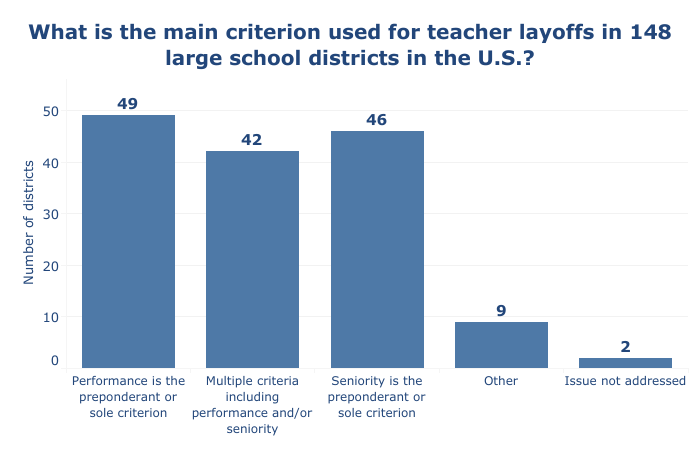Amidst frequent news stories of teacher shortages, layoffs may feel far from relevant. Yet decreased student enrollment in public schools and the impending “fiscal cliff” as federal ESSER funds (often used to support new positions) dry up, may mean that some schools find themselves with reduced budgets and more teachers than funded positions.
While we hope layoffs will not occur, districts should proactively prepare for this possibility by reviewing and reconsidering how their district identifies teachers for layoffs. As students and schools continue to recover from the pandemic, layoff policies that put more effective teachers at risk may further hamper recovery efforts, and of particular concern, undercut the important strides districts have recently made to diversify their teacher workforce.
This District Trendline examines the layoff policies of 148 of the largest school districts in the U.S.,1 exploring their impact on the teacher workforce and in turn, our nation’s students.
What criteria do large districts use for teacher layoffs?2
The most frequent criterion districts consider in layoff policies is seniority, where districts follow a “last in, first out” (LIFO) approach. With this policy, teachers who were the last to be hired are the first to be excised, and those with more experience (seniority) are retained. The other criterion most often considered in layoff decisions is performance, in which teachers with the lowest evaluation ratings are the first to be let go.
Forty-six districts in our sample (or 31%) use seniority as the preponderant or sole criterion for teacher layoffs. This percentage has remained relatively stable over the last five years. In nearly two-thirds of these districts (28 districts), seniority is the only criterion considered for teacher layoffs. Seniority is almost always established at the district level, rather than at the school level (with the exception of Burlington School District (VT), where seniority is determined at the district level for elementary teachers and teachers of specials, while middle school and high school teachers are laid off based on their subject areas and need within their school).
Another 49 districts (or 33%) use performance as the preponderant or sole criterion for teacher layoffs. This signifies a decrease of nearly 10 percentage points in the share of districts that rely primarily on performance compared to five years ago. Of these 49 districts, seven rely solely on teachers’ performance when determining layoffs. In six of the 49 districts, they first lay off teachers from the pool of non-tenured teachers, based on their performance, and only after that do they lay off from the pool of tenured teachers, based on their performance. In practice, this still implies that early career teachers are laid off first.
Several districts explicitly identify the district’s staffing needs or the teachers’ licensure areas as one consideration. For example, Desoto County School District (MS) identifies licensure and curriculum or program needs among its criteria, while Kansas City Public Schools (MO) includes certification and programmatic needs as the most important criteria. Omaha Public Schools (NE) similarly targets reductions by subject area.
A more holistic approach—the use of multiple criteria, including performance and/or seniority—has become a more prevalent method for laying off teachers, and the share of districts in this category has increased by about 10 percentage points compared to five years ago.

Some of the additional criteria used to determine which teachers are let go include whether the teacher has specific qualifications that are in high demand in the district (e.g., bilingual certification), whether the teacher performs additional duties (e.g., department or grade level chair or band director), the teacher’s attendance, and discipline records. Little Rock School District (AR) uses a Reduction in Force rubric to assign teachers a score. The domains of seniority, performance evaluation rating, professional development, educational preparation, and other qualifications/skills each carry weights of up to 25 points, followed by attendance (5 points) and armed forces veteran status (1 point). Mobile County Public Schools (AL) includes among their criteria whether a teacher holds a regular or a provisional certificate, with fully certified teachers given preference on retaining their position over provisionally certified teachers.
In some cases, the criteria for reductions in force are not fully established in district policy. In the case of Desoto County School District (MS), for example, “(e)mployee reduction shall be dictated by licensure, experience, curriculum or program needs, accreditation requirements, and quality of performance, among other factors at the discretion of the school district” (emphasis added). Similarly, in the District of Columbia Public Schools (DC), the restructuring team, personnel committee, and supervisors make recommendations as to the areas of certification and the teachers within those areas to be affected by the layoffs, but the district retains the right to make final layoff decisions using a rubric that assigns the greatest weight to a teacher’s previous year’s final evaluation.
Only a small portion of districts (10%, or 17 of the 148 districts) set clear guidelines about when during the school year teachers must be notified of layoffs.
How do teacher layoff policies impact the goal of diversifying the teacher workforce?
Concentrating layoffs among one group of teachers will inevitably change the composition of the teacher workforce in ways that could potentially work against students’ best interests. Recent research by Matthew Kraft and Joshua Bleiberg3 concludes that “last in, first out” or LIFO policies are inequitably distributed and concentrated to disproportionately lay off teachers of color, who are more likely to be early career teachers.
This finding is especially relevant given evidence that incoming teachers are more racially diverse than the current teacher workforce. According to the Title II 2021 report, teacher preparation program completers of color increased by 5% in the last recorded year, which corresponds to teachers that would have entered the workforce in 2021 or 2022. Similarly, both pre-pandemic, national research4 and more recent research from Massachusetts5 during the pandemic indicates that beginning teachers are more racially diverse than their more experienced counterparts. Nationally, this is a result of increased certification via alternate routes into the teaching profession, and in Massachusetts, this demographic shift is likely due to emergency licenses offered during the pandemic. In Boston Public Schools (MA), performance is the preponderant layoff criterion, but non-tenured early career teachers are laid off first, which could undo the recent improvements in diversifying the district’s teacher workforce.
Some districts are addressing this connection between teacher diversity and layoff policies. The new contract in Minneapolis Public Schools, a district that otherwise relies on LIFO policies, stipulates that “if excessing a teacher who is a member of a population underrepresented6 among licensed teachers in the site, the District shall excess the next least senior teacher, who is not a member of an underrepresented population.” This provision takes effect in the Spring of 2023.
How would layoffs impact students?
Kraft and Bleiberg’s research shows that LIFO policies disproportionately impact students from low income backgrounds or students of color. These students are more likely to be taught by early career teachers, and LIFO policies create more vacancies, increases turnover, and potentially removes high-performing, early career teachers.
Unfortunately, school districts that rely on seniority or LIFO policies as teacher layoff criteria are more likely to have both larger percentages of students of color, as well as larger percentages of students living in poverty, compared to the districts that rely mainly on performance or on multiple criteria to inform layoff decisions. In NCTQ’s sample, the average percentage of students of color in districts that rely on performance as main or sole criterion for layoffs is 47%, while the average percentage of students of color in districts that rely mainly or exclusively on seniority is 55%. Taken together, this implies that LIFO policies may reduce much needed teacher diversity in the school districts with the greatest student racial diversity.
Similarly, in districts that rely mainly or solely on seniority as layoff criterion, an average 60% of students qualify for free or reduced price lunch (FRL), a proxy for students living in poverty. This is, on average, seven percentage points higher than the proportion of FRL qualifying students in districts that rely mainly or solely on seniority as layoff criterion. When districts with many students living in poverty make layoff decisions based on LIFO provisions rather than performance, the students who most need greater educational opportunities are more likely to lose out on highly effective teachers.
Conclusions and recommendations
Relying exclusively on seniority threatens the twin goals of diversity and effectiveness. While districts have moved to include more criteria when layoffs decisions are necessary, many districts, in particular those serving larger proportions of disadvantaged students, still rely mostly on seniority rather than other measures, including teacher effectiveness, to determine which teachers to let go.
Students benefit both from having diverse and effective teachers. Given the negative effects that the pandemic has had on student learning, and the disproportionate impact on students of color and students living in poverty, districts that serve these students should evaluate their layoff policies in order to promote equity and effectiveness in their teacher workforce.
More like this

Planning time may help mitigate teacher burnout—but how much planning time do teachers get?

Six steps to hire a strong teacher workforce

The very real damage to student learning from pink slips
Endnotes
- The sample for this analysis, drawn from NCTQ’s Teacher Contract Database, consists of 148 school districts in the United States: the 100 largest districts in the country, the largest district in each state, and the member districts of the Council of Great City Schools.
- Of the 148 districts in NCTQ’s sample, 7 districts do not specify layoff criteria, but the state has a clear policy for all of its districts, which was applied to the district for the purpose of this analysis. Similarly, 12 districts acknowledged state law, in which case state criteria for layoffs were applied to the district.
- Kraft, M. A., & Bleiberg, J. F. (2022). The inequitable effects of teacher layoffs: What we know and can do. Education Finance and Policy, 17(2), 367-377.
- Redding, C. (2022). Changing the composition of beginning teachers: The role of state alternative certification policies. Educational Policy, 36(7), 1791-1820.
- Bacher-Hicks, A., Chi, O., & Orellana, A. (2022). Two years later: How COVID-19 has shaped the teacher workforce. Wheelock Educational Policy Center. https://wheelockpolicycenter. org/effective-teachers/covid-19-and-ma-teacher-workforce.
- The term “underrepresented” is defined in the contract in the context of race “as compared to the labor market and to the community served by the school district.”


